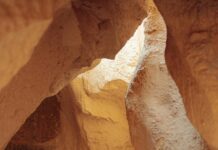If you ever wondered where to uncover the most fascinating ancient secrets in the heart of Nevada, the Las Vegas Natural History Museum is your ultimate destination. This incredible museum offers an unforgettable journey through time, showcasing rare fossils, ancient artifacts, and captivating exhibits that bring prehistoric worlds back to life. Whether you’re a history buff, a curious family, or someone searching for an exciting educational adventure, the Las Vegas Natural History Museum promises to deliver an experience that’s both entertaining and enlightening. You’ll find yourself asking, what hidden treasures lie beneath the sands of Las Vegas?
Step inside and explore the ancient civilizations exhibits, featuring everything from dinosaur skeletons to Egyptian mummies, that reveal the mysteries of our planet’s distant past. The museum’s diverse collection highlights not only the natural history of Nevada but also global wonders, making it a must-visit spot for those who want to dive deep into prehistoric history and ancient artifacts in Las Vegas. Did you know the museum houses one of the most extensive dinosaur fossil collections in the Southwest? This makes it an exciting hotspot for fossil enthusiasts and families looking for a unique outing.
In today’s fast-paced world, finding places that combine education with adventure can be rare, but the Las Vegas Natural History Museum stands out as a vibrant hub for discovery. From interactive exhibits to special events focusing on natural science and ancient history, visitors can immerse themselves in stories that shaped our world. So, why not plan your next visit and uncover the secrets that’ve been buried for millions of years right here in Las Vegas? Don’t miss out on exploring one of the top Las Vegas attractions for families and history lovers!
Explore 7 Must-See Exhibits at the Las Vegas Natural History Museum for Ancient History Buffs
If you ever find yourself wandering the vibrant city of Las Vegas and have a passion for ancient history, the Las Vegas Natural History Museum is a spot you don’t want to miss. This museum offers a glimpse into the distant past, with exhibits that reveal the mysteries and wonders of ancient civilizations and prehistoric life. It’s a perfect place for those who loves to unravel the secrets of history and explore the fascinating stories that shaped our world.
1. Dinosaurs of the Desert
One of the most popular exhibits at the museum is the Dinosaurs of the Desert. Visitors can see life-sized replicas of dinosaurs that once roamed what is now the Nevada desert. Unlike some places that only show a few skeletons, here you get a whole experience with moving models and interactive displays. You learn about how these creatures lived millions of years ago, their diets, and the environments they thrived in. For example, you might discover that the T-Rex wasn’t the only giant predator around during the late Cretaceous period.
2. Ancient Egypt: Mysteries of the Pharaohs
Step inside the Ancient Egypt exhibit and you’ll be transported back to the time of the Pharaohs. The museum shows real artifacts such as pottery, jewelry, and replicas of sarcophagi that tells about Egyptian beliefs in the afterlife. You will see hieroglyphics carved on stone tablets and learn about the construction of the pyramids. This exhibit also explains the daily life of Egyptians, including their religious practices and social structure. It’s not just about the impressive tombs; it’s about the people behind them.
3. Early Humans and Their Tools
The story of human evolution is long and complicated, but the Las Vegas Natural History Museum makes it easier to understand. This section showcases early human tools and fossils that marks the transition from primitive life to more advanced societies. You can compare stone tools from different time periods and see how technology evolved over thousands of years. It’s fascinating to observe how these simple inventions paved the way for agriculture, writing, and civilization.
4. Nevada Prehistoric Creatures
Did you know Nevada was once under a vast ocean? The Nevada Prehistoric Creatures exhibit highlights marine life that lived here millions of years ago. Fossils of ancient sharks, fish, and even giant sea reptiles are displayed with explanations about the geological changes that transformed the region. This exhibit helps visitors understand how the earth’s surface has changed dramatically, influencing the evolution of life on land and sea.
5. Native American Artifacts and Culture
The museum also dedicates a section to Native American history, showcasing artifacts from tribes that inhabited Nevada long before modern cities appeared. You will see tools, clothing, and artwork that reflect the rich cultural heritage of these peoples. This exhibit not only shows their daily life but also their spiritual beliefs and connections to nature. Learning about the Native American influence in the region provides a deeper appreciation for the land’s history.
6. Fossil Discoveries from Around the World
For those who curious about fossils beyond Nevada, the museum presents an impressive collection from different continents. You can compare fossils of ancient mammals, reptiles, and plants from North America, Africa, and Asia. This global perspective helps visitors understand the diversity of life on Earth and the interconnectedness of ecosystems across time. It’s like taking a world tour through the lens of prehistoric life.
7. The Ice Age: Life in a Frozen World
The Ice Age exhibit reveals the harsh conditions animals and humans faced during the last glacial period. You can see replicas of mammoths, saber-toothed cats, and giant ground sloths that roamed North America. This section explains how climate changes affected migration, survival, and extinction. It also explores how early humans adapted to these challenging environments, using innovative tools and strategies.
The Las Vegas Natural History Museum is not just a place with dusty old stuff. It’s a vibrant journey through time that lets visitors connect with ancient worlds. Whether you are fascinated by dinosaurs, intrigued by the mysteries of Egypt, or interested in the history of Native Americans, the museum has something special for you. Plus, it’s located conveniently in downtown Las Vegas, making it an easy stop during your city exploration.
If you plan a visit, consider spending a few hours because each exhibit offers detailed information and interactive elements that you don’t want rush through. Also, check the museum’s schedule for special events or temporary exhibits that sometimes feature rare artifacts or guest lectures by historians and scientists.
In summary, the Las Vegas Natural History Museum is a treasure trove for ancient history buffs. It offers a unique chance to discover fascinating ancient secrets and understand how the past shaped the present. So next time you’re in Las Vegas, explore these seven must-see exhibits and dive into the captivating story of life on Earth. You might just leave with a new appreciation for the ancient world and its incredible legacy.
How the Las Vegas Natural History Museum Reveals Hidden Secrets of Prehistoric Creatures
The Las Vegas Natural History Museum is much more than just a place to see old bones and dusty fossils. It’s a gateway to the past, where prehistoric creatures come alive through exhibits and stories that reveals secrets hidden for millions of years. Visitors, whether locals or tourists, can dive deep into ancient worlds, learning about creatures that once roamed the Earth long before humans existed. If you ever wonder how these massive beasts lived, or what the Earth looked like in prehistoric times, this museum gives a fascinating glimpse that you won’t find anywhere else in Las Vegas.
Exploring Prehistoric Creatures at the Las Vegas Natural History Museum
One of the most exciting parts about visiting the Las Vegas Natural History Museum is the chance to discover prehistoric creatures up close. These are animals like dinosaurs, ancient mammals, and marine reptiles that lived in times that feel like a distant dream. The museum’s collection includes fossils, skeletons, and life-size models that show how these creatures might have looked and behaved.
Some highlights you can expect to see:
- Tyrannosaurus rex skeleton: One of the most famous dinosaurs, known for its massive size and sharp teeth.
- Triceratops skulls: With their distinctive three horns and large frills.
- Ancient sea creatures: Fossils of marine reptiles like mosasaurs that dominated prehistoric oceans.
- Ice Age mammals: Such as mammoths and saber-toothed cats that roamed North America during colder periods.
Each display not only shows the physical structure but also provides information about the creature’s environment, diet, and how it might have interacted with other species. This makes it easier for visitors to imagine a world that’s long gone but still connected to the history of our planet.
How the Museum Reveals Hidden Secrets of Prehistoric Life
The Las Vegas Natural History Museum isn’t just about showing fossils; it also explains how scientists uncover these ancient secrets. The process of discovering and understanding prehistoric creatures involve lots of research, excavation, and sometimes a bit of luck. The museum educates visitors on these scientific methods, making the experience both educational and thrilling.
Here’s how the museum reveals hidden secrets:
- Fossil Excavation Techniques: Visitors learn about how paleontologists dig up fossils carefully to avoid damaging them.
- Dating Methods: The museum explains carbon dating and other techniques used to figure out how old fossils are.
- Reconstruction: Showing how scientists use fragmented bones to reconstruct entire skeletons or even imagine the living creature.
- Comparative Anatomy: Comparing prehistoric animals with modern-day species to understand evolution and adaptation.
The museum often hold special exhibits or workshops on these topics, encouraging kids and adults alike to get involved with hands-on experiences. This makes the ancient past feel more real and accessible, even for those who never studied history or science before.
Unique Features That Set Las Vegas Natural History Museum Apart
While many natural history museums exist across the country, the Las Vegas Natural History Museum has some unique elements that make it stand out. For one, it combines local history with global prehistoric stories, connecting the Las Vegas region’s geological past with wider Earth history.
Unique features include:
- A special section dedicated to Nevada’s prehistoric environment, showing fossils and artifacts found in the nearby desert regions.
- Interactive exhibits that allow visitors to touch fossils or use digital screens to explore ancient habitats.
- Displays that showcase the evolution of life from single-celled organisms to complex mammals, giving a full timeline of prehistoric life.
- Temporary exhibits that bring in rare fossils or focus on specific themes, such as dinosaurs from different continents or extinct marine life.
These features make the museum a dynamic place that changes with new discoveries, keeping visitors coming back to see what’s new.
Practical Tips for Visiting the Las Vegas Natural History Museum
If you decide to explore these fascinating ancient secrets yourself, here is a quick guide to make the most out of your visit:
- Plan to spend at least 2 hours to see all the major exhibits comfortably.
- Check the museum’s website before you go for any special exhibits or events.
- Bring kids along because there are many educational programs designed just for young learners.
- Don’t miss the dioramas and life-size models; they really bring prehistoric creatures to life.
- Photography is usually allowed, so remember to capture your favorite moments.
- Combine your visit with other nearby attractions in downtown Las Vegas for a full day of exploration.
By following these tips, you can immerse yourself fully in the world of prehistoric creatures and understand more about the natural history of Las Vegas and the planet.
Table: Comparison of Prehistoric Creatures Exhibited at the Museum
| Creature | Period | Key Features | Diet | Interesting Fact |
|---|---|---|---|---|
| Tyrannosaurus rex |
Top 5 Fascinating Dinosaur Fossils You Can Discover at the Las Vegas Natural History Museum
Las Vegas is known for its bright lights, entertainment, and endless excitement, but tucked away from the Strip lies a treasure trove of ancient mysteries waiting to be discovered. The Las Vegas Natural History Museum offers visitors an incredible journey back in time, where you can explore the fascinating world of dinosaurs through some of the most remarkable fossils ever found. If you think Vegas is just about casinos and shows, think again. The museum reveals secrets from millions of years ago, offering a unique experience that combines education with wonder. Here, we take a look at the top 5 fascinating dinosaur fossils you can discover at the Las Vegas Natural History Museum, and why this place should be on your must-visit list.
1. The Giant T-Rex Skull
One of the most jaw-dropping exhibits at the museum is the gigantic Tyrannosaurus rex skull. This fossil, measuring over 4 feet long, shows the sheer power and ferocity of this apex predator. The T-Rex lived around 68 to 66 million years ago during the late Cretaceous period, and its skull is a perfect example of how evolution equipped it with strong jaws and sharp teeth to crush bones and prey alike. Visitors often get amazed by the size and detail of this skull, which was carefully reconstructed from fossil fragments found in North America.
- Estimated age: 66 million years old
- Length of skull: 4.5 feet
- Discovered: Montana, USA
- Fun fact: T-Rex had one of the strongest bite forces of any land animal ever.
This fossil not just tells the story of a predator but also sparks curiosity about the ecosystems these creatures thrived in.
2. The Stegosaurus Plates
Another exhibit that catches eyes is the impressive Stegosaurus plates. These bony plates run down the back of the Stegosaurus, a herbivore that roamed the earth during the Jurassic period roughly 150 million years ago. While the purpose of these plates is still debated among scientists, most agree they were used for display, thermoregulation, or protection. The museum’s display features real fossilized plates, arranged in a way that gives visitors a sense of how it looked alive.
- Period: Late Jurassic (about 150 million years ago)
- Length of Stegosaurus: Up to 30 feet
- Unique feature: Double row of large, bony plates and spiked tail
- Display highlights: Fossilized plates with detailed textures
Seeing these plates up close is a rare opportunity, as fossils of this quality are not very common in many museums.
3. Velociraptor Claw Fossil
The Velociraptor, made famous by movies, is often misunderstood. The Las Vegas Natural History Museum houses a genuine Velociraptor claw fossil that visitors can examine closely. This small but deadly claw was a key weapon for the Velociraptor, used to slash and grip prey. Unlike their Hollywood portrayal, real Velociraptors were much smaller, about the size of a turkey, but highly agile and intelligent. The claw fossil lets you appreciate the intricacy of dinosaur anatomy and their hunting strategies.
- Length of claw: About 3 inches
- Period: Late Cretaceous (75-71 million years ago)
- Discovered: Mongolia
- Interesting fact: Velociraptor had feathers, linking it closely to modern birds.
This fossil helps connect the dots between dinosaurs and the birds we see today, showing evolution in action.
4. Triceratops Frill and Horns
One cannot miss the massive frill and horns of the Triceratops, one of the most recognizable dinosaurs. The museum displays a stunning fossil set of the Triceratops’ skull, complete with its iconic three horns and large bony frill. These dinosaurs lived about 68 to 66 million years ago, and their horns were probably used for defense against predators as well as for combat with other Triceratops. The frill might have served multiple purposes, including species recognition and temperature control.
- Period: Late Cretaceous
- Horn length: Up to 3 feet
- Skull width: Over 7 feet
- Display includes: Skull fragments and full-size replicas
Visitors often compare the Triceratops’ features to modern animals like rhinos, noticing how nature reuses successful designs.
5. The Pterosaur Wing Fossil
Though not a dinosaur, the Pterosaur is closely related and often mistaken for one. The Las Vegas Natural History Museum’s Pterosaur wing fossil gives a glimpse into the world’s first flying reptiles. These creatures had wingspans up to 30 feet and soared the skies during the Mesozoic Era. The fossilized wing bones are fragile and rare, showing the lightweight structure that allowed flight millions of years before birds evolved.
- Era: Mesozoic
Why Visiting the Las Vegas Natural History Museum Is a Perfect Family Adventure in 2024
Exploring the Las Vegas Natural History Museum in 2024 offers a unique chance for families to dive into a world of discovery, education, and fun. This spot is more than just a museum; it’s a gateway to the fascinating ancient secrets that built our planet and the diverse creatures that once roamed it. If you’re wondering why this place should be in your family’s itinerary, keep reading to find out all the reasons why visiting the Las Vegas Natural History Museum is a perfect family adventure.
Why Las Vegas Natural History Museum Stands Out
The Las Vegas Natural History Museum is located in downtown Las Vegas, making it easily accessible for locals and tourists alike. Unlike typical museums that might bore younger visitors, this museum offers interactive exhibits that keep kids engaged while adults appreciate the rich scientific content. The museum has been around since 1967, so it has had decades to build a solid reputation for quality education and entertainment.
Visitors can walk through various galleries that cover everything from dinosaur fossils to marine life, ancient Egypt, and even wildlife from the African savanna. The blend of exhibits makes it a place where learning feels like an adventure, not a chore.
Discover Fascinating Ancient Secrets
One of the museum’s biggest draws is its collection of ancient artifacts and fossils. For example, the Dinosaur Gallery is a favorite among children. It features life-sized replicas of T. rex and Triceratops skeletons, which sparks imagination about the prehistoric world. You can see how these creatures might have looked millions of years ago, providing a tangible connection to a time long gone.
Another highlight is the Ancient Egypt exhibit that showcase authentic artifacts, including mummies and sarcophagi. These displays provide insight into Egyptian burial customs and the beliefs about the afterlife. It’s not just history, but a glimpse into how ancient civilizations lived and thought.
Educational Benefits for Kids and Adults
The museum designed its exhibits to be educational, but in a way that is approachable and enjoyable for all ages. For kids, this means hands-on activities like fossil digs and interactive touch screens. Adults can dive deeper with detailed informational plaques and occasional expert talks that explain the science behind each exhibit.
Here’s a quick list of what families can expect educationally:
- Learn about the evolution of life on Earth from prehistoric times to the present.
- Understand the biodiversity of different ecosystems, like deserts and oceans.
- Discover the cultural history of ancient civilizations, such as Egypt.
- Experience live demonstrations or workshops during special events.
Practical Tips for Visiting
Planning a visit to the Las Vegas Natural History Museum can be very straightforward, but here are some tips to get the most out of your trip:
- The museum opens daily from 9 AM to 4 PM, so it’s best to arrive early to avoid crowds.
- Tickets are reasonably priced, and children under 3 get in free.
- There is a small café on-site where you can grab snacks and drinks, but packing your own lunch is also a good idea for longer visits.
- Parking is available nearby, but public transportation options exist if you want to avoid driving.
Comparing with Other Attractions in Las Vegas
Las Vegas is known for its vibrant nightlife and entertainment, but the Natural History Museum offers a much different experience that’s educational and family-friendly. Compared to the flashy shows or casinos, the museum provides a calm atmosphere where kids can run around and learn without restrictions.
Here’s a simple comparison table to understand why the museum might be your best bet for a family outing:
| Feature | Las Vegas Natural History Museum | Typical Vegas Shows | Casinos |
|---|---|---|---|
| Family Friendly | Yes | Mostly no | No |
| Educational Value | High | Low | None |
| Cost | Affordable | Expensive | Varies |
| Interactive Exhibits | Many | Few | None |
| Suitable for Young Children | Yes | Rarely | No |
Unique Exhibits You Can’t Miss
It’s not only about dinosaurs and mummies here. The museum also houses a live animal exhibit where you can see reptiles and exotic birds up close. This helps connect the ancient past with living creatures today.
Another fun section is the Las Vegas exhibit, where you learn about the natural history of the area surrounding the city. It’s a reminder that even a bustling metropolis like Las Vegas has roots in nature and geology.
What Makes 2024 Special to Visit?
The museum keeps updating and adding new exhibits, and in 2024, they’ve introduced several new interactive displays focusing on climate change and its impact on wildlife. These additions make the museum not only a place to learn about the past but also about the future challenges we face.
You might also find special events or family workshops scheduled throughout the year. These programs help children and adults alike to engage more deeply with the topics presented.
Unlocking the Mysteries of Nevada’s Ancient Past: Exclusive Insights from the Las Vegas Natural History Museum
Unlocking the Mysteries of Nevada’s Ancient Past: Exclusive Insights from the Las Vegas Natural History Museum
Nevada is not just about neon lights and bustling casinos; it holds secrets thousands of years old beneath its desert sands. The Las Vegas Natural History Museum invites visitors to step back in time and explore these mysteries that shaped the region long before the bright lights of the Strip ever existed. The museum offers a unique window into Nevada’s ancient past, revealing fascinating stories through its extensive exhibits. If you ever wonder about the origins of the land and the creatures that roamed here, this place is a must-see.
Discover Fascinating Ancient Secrets at the Las Vegas Natural History Museum
Located in downtown Las Vegas, the Las Vegas Natural History Museum showcases an impressive collection ranging from prehistoric fossils to ancient artifacts. It’s not just a collection of bones and stones; it’s a journey through the epochs that formed Nevada’s landscape and ecosystems. The museum’s layout takes you through different eras, showing how life evolved from primitive times to modern days.
Visitors can find exhibits dedicated to:
- Dinosaurs that once roamed the Southwest
- Ice Age mammals that adapted to the changing climate
- Indigenous cultures who left their marks in the area
- Geological formations unique to Nevada’s deserts and mountains
The museum also features interactive displays that allow young and old to engage with history in a hands-on manner, making it educational and entertaining simultaneously.
Nevada’s Ancient Giants: Dinosaurs and Ice Age Creatures
One of the most captivating sections of the museum is its dinosaur exhibit. Although Nevada isn’t as famous for dinosaur fossils as other states, recent discoveries have revealed that it was once a habitat for several ancient species. The museum displays skeletal reconstructions and fossil replicas of creatures such as the hadrosaur, a duck-billed dinosaur that thrived during the Late Cretaceous period.
Another highlight is the Ice Age gallery, which illustrates the mammoths, saber-toothed cats, and giant ground sloths that inhabited the region during the Pleistocene epoch. This part of the exhibit explains how dramatic climate changes affected the migration and survival of these species.
A Glimpse Into Indigenous History and Culture
Nevada’s ancient past isn’t only about animals; it also tells the story of human beings who lived on this land thousands of years ago. The Las Vegas Natural History Museum dedicates a section to Native American history, showcasing tools, pottery, and artifacts from the Paiute and other tribes native to the region.
This section explains how indigenous peoples adapted to the arid environment, developed complex societies, and left behind petroglyphs and artifacts that still intrigue archaeologists today. It’s a reminder that Nevada’s history is deeply intertwined with the cultures that preceded modern settlers.
Geological Wonders of Nevada Uncovered
The museum also explores the geological history that shaped Nevada’s stunning landscapes. Visitors can learn about the tectonic forces that created the Basin and Range province, characterized by its alternating mountains and valleys.
Here is a brief outline of what you can learn:
- Formation of the Sierra Nevada and other mountain ranges
- Role of volcanic activity in shaping the terrain
- Impact of ancient lakes such as Lake Lahontan on local ecosystems
- Mineral resources and their influence on Nevada’s development
Understanding these geological processes provides context for why Nevada looks like it does today and why it was able to support such diverse life forms over millennia.
Comparing Nevada’s Past With Other Regions
When comparing Nevada’s ancient history with neighboring states, it becomes clear that each area holds unique stories despite some overlap. For example:
| Aspect | Nevada | California | Arizona |
|---|---|---|---|
| Dinosaur fossils | Less abundant but significant finds | Rich in diverse dinosaur fossils | Known for early dinosaur species |
| Ice Age remnants | Mammoths and saber-toothed cats | Similar Ice Age fauna | Less Ice Age evidence |
| Indigenous cultures | Paiute, Shoshone | Chumash, Miwok | Navajo, Hopi |
| Geological features | Basin and Range province | Sierra Nevada, Central Valley | Colorado Plateau |
This comparison helps visitors appreciate the distinctiveness of Nevada’s ancient heritage.
Practical Tips for Visiting the Museum
If you plan to visit the Las Vegas Natural History Museum, here are some useful tips to enhance your experience:
- Arrive early to avoid crowds, especially on weekends.
- Allocate at least 2 hours to explore the exhibits thoroughly.
- Participate in guided tours if available, as they offer additional insights.
- Check the museum’s website for special events or temporary exhibitions.
- Bring children along; the interactive displays are great for family learning.
The museum is accessible by public transportation and offers parking facilities for those driving. Admission fees are reasonable, making it an affordable outing for residents and tourists alike.
The Las Vegas Natural History Museum
Conclusion
Visiting the Las Vegas Natural History Museum offers an enriching experience that combines education, exploration, and entertainment for visitors of all ages. From its impressive dinosaur exhibits to the captivating marine life displays and fascinating cultural artifacts, the museum provides a comprehensive glimpse into the natural world and human history. It serves not only as a fun destination but also as a valuable resource for learning about biodiversity, geology, and ancient civilizations. Whether you’re a local looking for a family-friendly outing or a tourist seeking a deeper understanding of the region’s natural heritage, the museum’s interactive exhibits and engaging programs make it a must-see attraction in Las Vegas. To truly appreciate the wonders of nature and history, plan your visit to the Las Vegas Natural History Museum and immerse yourself in a world of discovery that inspires curiosity and lifelong learning. Don’t miss the chance to explore this hidden gem in the heart of the city.











